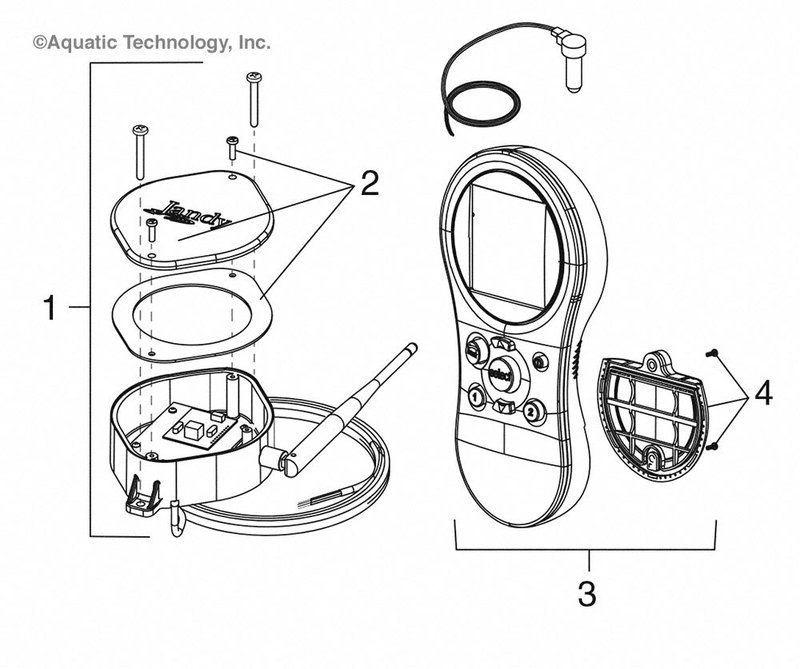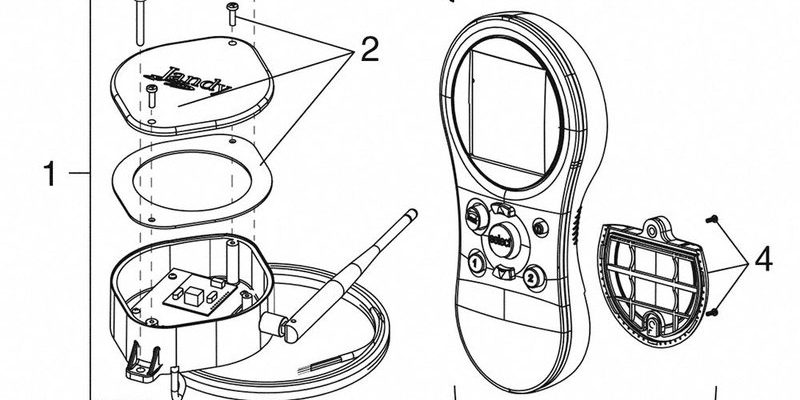
Here’s the thing: even the fanciest remotes, like the ones from Jandy, can run into problems getting their signals through. Wireless devices are a bit like chatty roommates—sometimes, they talk over each other, or someone’s blasting music in the next room (hello, Wi-Fi router), and suddenly they can’t hear each other at all. Signal interference on your Jandy remote is pretty much the same deal. Let me walk you through why this happens, how to spot it, and—most importantly—how to fix it so you can get back to controlling your pool with a couple of clicks.
What Is Signal Interference, Anyway?
Let me explain. Imagine your Jandy remote is a walkie-talkie, sending out instructions to your pool equipment. Signal interference is anything that garbles or blocks that message before it gets to its destination. This could come from other electronic devices (like microwaves or Wi-Fi routers), thick walls, or even a dying battery in your remote. When interference strikes, your remote might lag, miss commands, or not work at all.
In most cases, *signal interference* happens because multiple devices are using the same frequency bands—sort of like two radio stations bleeding into each other. Jandy’s wireless pool remotes often use standard RF (radio frequency) signals, which makes them pretty reliable most days. But “real-world” homes are noisy places, and things like Bluetooth speakers, baby monitors, and even cordless phones can crowd the airwaves.
You might be wondering: how can something like a Wi-Fi connection mess with my pool remote? Well, many household gadgets operate on similar frequencies (like 2.4 GHz or 900 MHz), and when too many signals overlap, they can’t all get through cleanly. That’s why troubleshooting signal interference on your Jandy remote isn’t just about the remote—it’s about understanding what’s going on around it.
Common Signs of Signal Interference on Jandy Remotes
Knowing what to look for is half the battle. If your Jandy remote isn’t working like it should, signal interference could be a big part of the problem. Here are some telltale signs your remote is facing interference, not just a random glitch:
- Delayed responses: You press a button and nothing happens, or there’s a weird lag before the pool responds.
- Intermittent control: Sometimes the remote works fine, other times it’s totally unresponsive—sometimes in the same spot.
- Partial command failures: Maybe you can turn on the pool lights, but can’t crank up the filter. Or vice versa.
- Complete loss of connection: No beeps, no lights, nothing—the remote is DOA until you do some troubleshooting.
Honestly, most of us just assume the batteries have died or the remote is broken. But if you notice any of these patterns—especially if they come and go at different times of day or when other devices are active—signal interference is likely to blame.
First Steps: Rule Out Simple Fixes
Let’s not overthink it—sometimes the simplest fixes do the trick. Before you mess with frequency channels or think about code resets, check the basics:
- Check the batteries: Weak batteries can create weak signals. Replace them with fresh ones and see if that brings your Jandy remote back to life.
- Look for obvious blockages: Stand closer to the receiver (the pool control panel or base station). Thick walls, metal doors, or even large bushes can weaken a radio signal.
- Move away from other electronics: Try using the remote away from Wi-Fi routers, Bluetooth speakers, or even your cordless phone. See if performance improves.
- Reset your Jandy remote: Power it off, wait a minute, then power it back on. Sometimes a simple hard reset can clear out temporary glitches.
If one of these fixes solves your problem, celebrate! If not, don’t worry—sometimes the interference goes deeper and needs a bit more detective work.
Diagnosing Interference: Where’s the Problem Coming From?
Alright, if you’ve ruled out the easy stuff, it’s time to dig a little deeper. Think of this like playing poolside detective. Signal interference often comes from hidden culprits.
First, ask yourself: When and where does the problem happen? For example, does the remote work in the backyard, but not through the kitchen window? Is it worse when the microwave’s running, or when everyone’s streaming Netflix?
Try these troubleshooting steps to narrow it down:
- Map out dead zones: Walk around your property with the remote. Note where it loses the signal or struggles to perform. This can help reveal if thick walls or metal structures are at fault.
- Check for new electronics: Did you install a new Wi-Fi booster, baby monitor, or smart home gadget recently? These can compete for radio frequencies and cause sudden interference.
- Test at different times: Sometimes, interference happens more during certain hours—like when neighbors’ devices are all running, or when your own house is buzzing with electronics.
If your Jandy remote only struggles in specific spots or at certain times, there’s a good chance another device nearby is crowding the signal or a structural barrier is making things worse.
How to Fix Signal Interference on Your Jandy Remote
Once you’ve pinned down that signal interference really is the villain, there’s a toolbox of solutions. Let me break down the most effective ways to get your Jandy remote back in control:
- Change the channel or frequency (if possible): Some Jandy remotes and receivers let you adjust their radio frequency code or channel. This is a mini version of changing the radio station—if one channel’s full of static, move to a quieter one. Check your remote’s manual for steps to pair or sync to a new code.
- Reposition your receiver: If the pool system’s base station is buried in a utility box or surrounded by metal panels, move it to a higher or more open spot. Just a few feet can make a difference.
- Add a signal booster or extender: Some pool professionals offer RF extenders designed for the Jandy remote system. These help the signal travel farther and “jump over” obstacles.
- Limit competing devices: Unplug or move other wireless devices, especially if they operate on a similar frequency. Cordless phones, old baby monitors, even wireless security cameras can all cause issues.
- Pair and resync the remote: Reset your remote and receiver, then follow the instructions to re-pair them. Sometimes, a fresh sync clears up interference by locking in a stronger, clearer code.
You might be surprised—a simple code reset and pair process can fix issues that seemed impossible. Just be sure to follow Jandy’s official pairing steps for your specific model.
When to Reset, Pair, or Replace Your Jandy Remote
Sometimes, even after tweaking channels and moving routers, the problem sticks around. Here’s when it’s time to get serious with your troubleshooting.
Resetting the Remote and Receiver
Resetting is like giving your Jandy system a clean slate. To do this, you’ll usually hold down a sync or reset button on the receiver, then press a pairing button on your remote. Check your user manual for the *exact* button combo, because it varies by model.
Resyncing should:
- Clear out any old, corrupted codes
- Help the remote “find” the receiver again
- Eliminate confusion if multiple remotes are in play
When to Replace Batteries or the Remote
If your remote is several years old, or you notice it burning through batteries quickly, the unit itself might be struggling to send a strong signal. Swapping in a new battery, or—if needed—a new Jandy remote, can solve issues that no amount of troubleshooting will fix.
Contacting Jandy Support
Let’s be real: sometimes you need a pro. If you’ve tried all the above and are still stuck, reach out to Jandy customer support or a pool service technician. Persistent signal interference could be a symptom of a failing receiver, a wiring issue, or rare but possible code conflicts.
Can Other Remotes or Controllers Work Better?
You might be wondering: should I switch to a universal pool remote, or even a wired controller, if my Jandy wireless keeps having issues? It’s a fair question.
Jandy remotes are designed to sync seamlessly with Jandy AquaLink and related systems. Universal remotes *sometimes* work, but they may not have all the features or might need special programming. A wired controller (mounted on the wall and hardwired to your pool system) is the most interference-proof option, because it bypasses wireless signals altogether.
Here’s a quick comparison:
| Remote Type | Pros | Cons |
| Jandy Wireless Remote | Convenient, portable, works with all Jandy pool equipment | Vulnerable to signal interference, needs batteries |
| Universal Remote | May control multiple brands or smart devices | Requires programming, may have limited features with Jandy |
| Wired Controller | Rock-solid reliability, no signal issues | Not portable, requires installation |
Honestly, for most folks, tweaking your setup to reduce interference is faster, cheaper, and easier than reworking your entire system. But if your environment is jam-packed with wireless devices, don’t rule out alternatives.
Pro Tips for Preventing Signal Issues in the Future
Let me finish with a few nuggets of wisdom for keeping your Jandy remote working smoothly long-term. Tiny habits can make a big difference.
- Keep batteries fresh: Old batteries are a sneaky source of weak signals. Swap them every season, especially before pool party season kicks in.
- Keep the receiver area clear: Try not to store big tools, paint cans, or other electronics near your pool equipment panel where the receiver sits.
- Check on new gadgets: Any time you bring a new wireless device home, keep an eye on your Jandy remote for new issues. If you spot a problem, test moving things around.
- Review your pairing and codes: If you change batteries or the remote acts up, run a quick code resync just to be safe.
Staying a step ahead of signal interference is mostly about being observant and a little proactive—think of it as low-key “pool system hygiene.”
Closing Thoughts: Enjoying Trouble-Free Poolside Control
Signal interference on your Jandy remote is a hassle, but it isn’t a mystery. Once you know what to look for and how to respond, you’re totally in the driver’s seat—no need for magic wands or tech wizardry. Most glitches come down to crowded frequencies, sleepy batteries, or small obstacles you can easily fix. By working through simple troubleshooting steps, paying attention to your environment, and knowing when to reset, pair, or ask for help, you’ll keep your pool controls running smoothly.
So the next time your Jandy remote feels stubborn, just remember: it’s usually just a matter of clearing the air, both figuratively and literally. Happy swimming—and may your signals always reach their mark!
